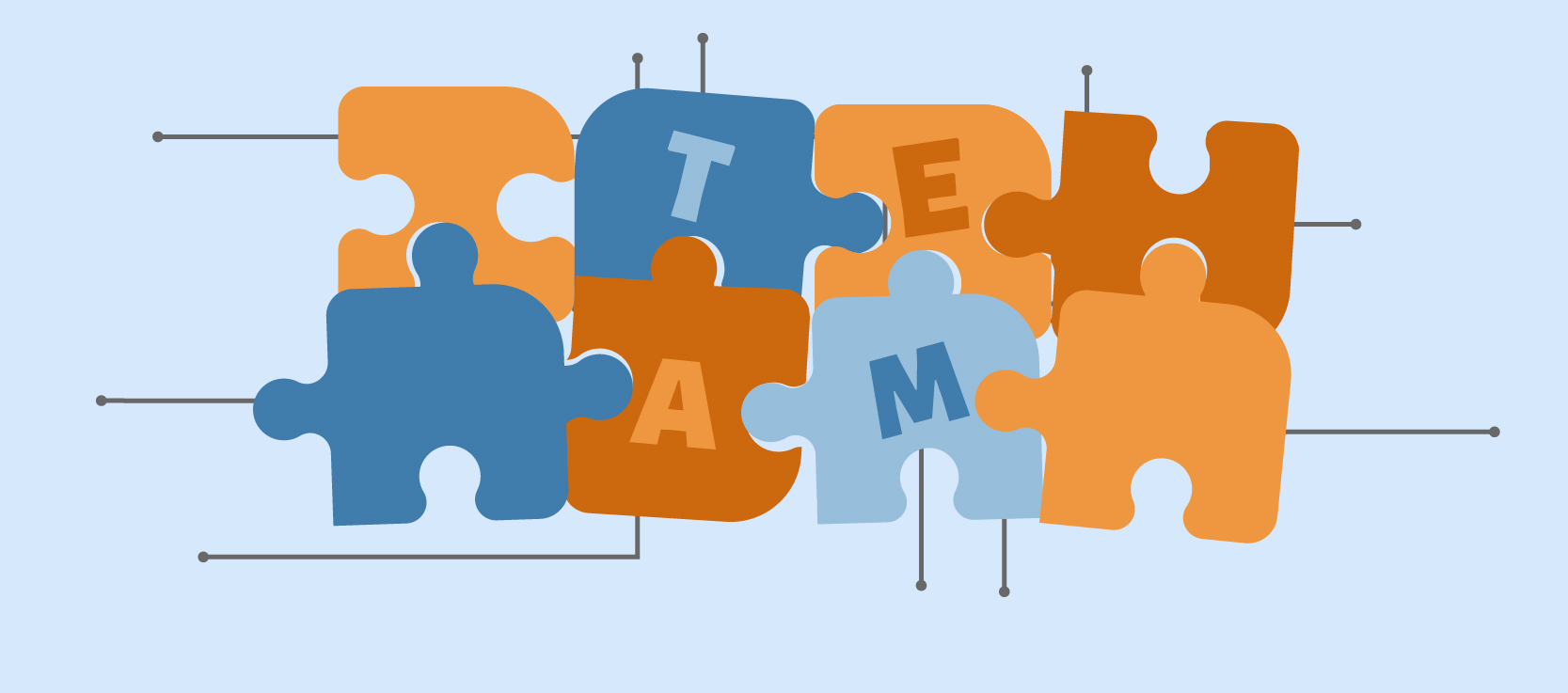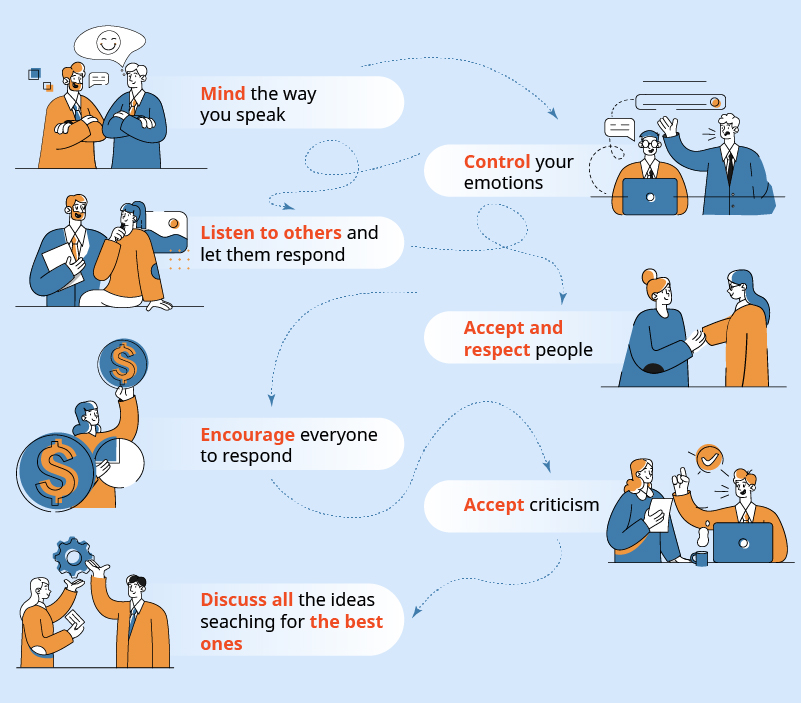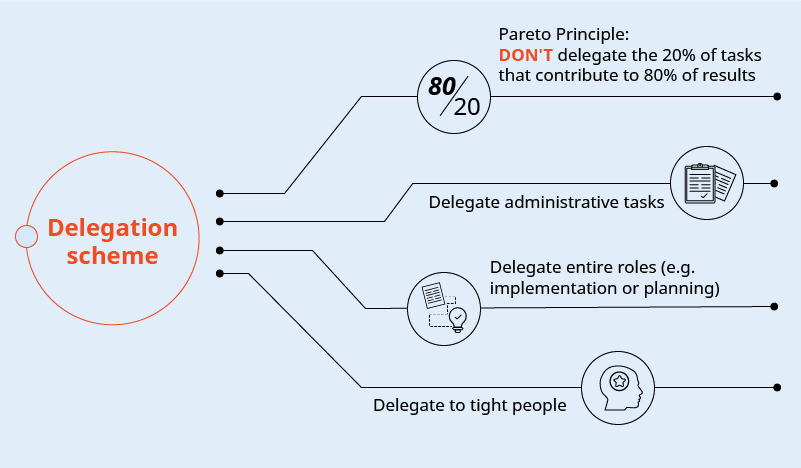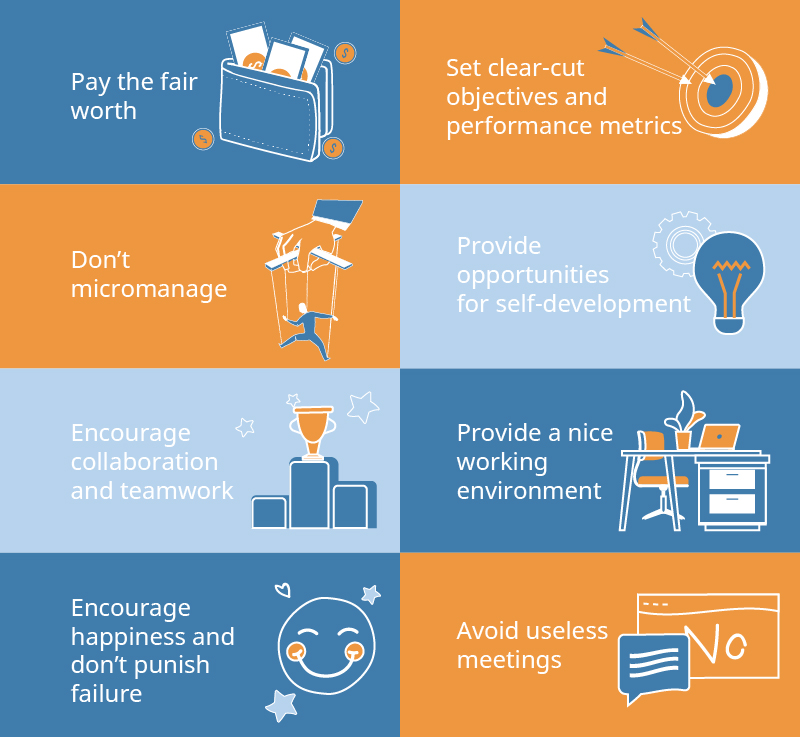“Talent wins games, but teamwork and intelligence win championships.”
– Michael Jordan
Building a team is a multidimensional challenge. The high-risk, high-reward nature of any business means that some companies will succeed, while others will fail. One piece of advice often mentioned in business books is to hire the best talent possible, as this will help drive a company toward success. However, when you start to assemble a promising team, you confront another challenge – one of the most neglected and misunderstood: management. How will you help employees be more productive, maintain happiness, foster personal growth, and contribute to the growth of the company as a whole? This article will benefit anyone who is building a team in high-growth competitive markets.
By the end of this article, you’ll learn:
- What team management is and what it involves
- What team management skills leaders must possess and nourish in their employees
- What apps for team management you can leverage to help build a more successful and productive team
Team management definition & meaning
Wikipedia offers the following definition for team management: “team management is the ability of an individual or an organization to administer and coordinate a group of individuals to perform a task.”
Team management includes, but is not limited to the following aspects: communication, teamwork, objective setting, performance assessment, and the capacity to identify and resolve conflicts (more on that later).
Team management theories and models

There are many workplace management theories, models, and approaches. However, most of them seem to strive to accomplish one goal: to increase a team’s productivity without affecting morale or compromising creativity and quality.
For example, according to the Systems Approach (based on Bertalanffy’s general system’s theory in biology), leaders are encouraged to think of their companies as systems that are governed by the same laws and behaviors that affect every living biological organization. The theory is based on the premise that while the main objective of a leader is to avoid a system running down or dying, it’s best achieved by making parts of a system (so-called subsystems) work together in harmony.
Max Weber, with his bureaucratic management theory, advocated for structuring business in a hierarchical manner with a clear division of labor, consistent regulations, recruitment, and promotion based on performance rather than favoritism.
Frederick Taylor thought it was best to apply science to management rather than philosophy, and advocated for standardization, specialization, training, and supervision in his scientific management theory.
In the mid-20th century, Douglas McGregor in his book The Human Side of Enterprise described two different styles of management. The so-called theories X and Y, wherein theory X managers perceived their employees as apathetic and unwilling to do their work, and in theory Y, as energetic and self-motivated. Of course, McGregor posited theory Y as the most favorable.
Classical management theory is based on employees having only physical needs, like money, and ignores the personal and social needs. Because of such insensitivity, the theory offers only a narrow view of the workforce and supports such principles as profit maximization, centralized leadership style, labor specialization, and single-person decision-making, thus ignoring motivational factors other than money.
Modern management, on the contrary, strives to combine both scientific and social variables in decision-making. Although modern management theory accentuates the use of mathematical techniques to understand the relationship between managers and employees, it’s based on the premise that the employees don’t work for money alone, but rather for happiness, satisfaction, appreciation, and lifestyle.
Team management components and concepts
Building a strong and productive team is no easy task. However, there are several key components which make up an efficient management system, and by employing those, you’ll greatly simplify the task.
Communication: inside and outside the team
One of the most important components of effective team management is communication. An effective communication channel from top to bottom and vice versa will allow for speedy and accurate delivery of any message to the intended recipient inside or outside of an organization. Effective communication increases the flexibility of the company and decreases its susceptibility to the external environment. Faster and more efficient delivery of information allows organizations to quickly respond to changes and execute contingency plans.
To keep the communication flowing, you, as a leader, must employ the right team management strategies to keep everyone on the team talking:
- Pay attention to your language and take responsibility for your emotions
- Listen and give space for others to respond
- Accept people as they are and honor where they are on their journeys
- Build strength in others and encourage everyone to speak up
- Accept criticism and respond intelligently
- Recover from command-and-control-ism: give your team space to come up with ideas and do what they do best
Aside from the strategies mentioned above, it’s important to think of technologies to employ that can help streamline communication across teams and departments. Knowing the right methods to communicate is as effective as having good communication skills. As a manager, you need to address all types of communication to make it more effective:
- Visual communication: charts, graphs, maps, pictures
- Verbal communication: face to face, phone, video
- Written communication: letters, emails, notifications, (short or instant) messages
We’ll recommend specific communication apps and software in the last section of this guide.
Delegation
Poorly defined roles and responsibilities are one of the major hurdles in building successful and productive teams. If employees don’t have a clear understanding of what their responsibilities entail, they won’t be able to perform their jobs effectively, and their contributions to the team will be minimal at best. Team leaders should evaluate the strengths and weaknesses of their team members, define their roles and responsibilities, and assign team management tasks accordingly.
Every time you think you need to solve something, bring it to your team. Let them tell you the root cause of the problem and what they will do about it. If you do everything on your own and tell others what to do, you run the risk of undermining your team’s ability to solve a problem on their own. When you delegate correctly, you motivate others and let them grow professionally.
Here are a few strategies on how to achieve effective delegation:
- Use Pareto principle: don’t delegate the 20% of tasks that contribute to 80% of your results. Instead, delegate low-risk tasks that you don’t feel attached to.
- Delegate administrative tasks: assign documenting, reporting, tracking tasks to those who do it best: administrative staff.
- Delegate entire roles: assign specific roles such as test management, implementation management, planning of services or products, user research, and so forth to other specialists. For smaller projects, you can tackle those roles on your own, whereas for larger projects, it’s best to find people who are professionals in their respective domains.
- Challenge and stretch: delegate to those whom you see can grow professionally as a result of accepting a new task or challenge from you.
Motivation
Motivation comes from the intrinsic desire to succeed. Financial benefits result from acquiring new skills, an interest in the subject matter, or curiosity. Motivation comes to fruition when people achieve autonomy, mastery, and a sense of purpose. Setting high performance as the standard expectation and giving teams the resources and opportunities to achieve that is a strong motivation on its own.
Here are a few tips on how to motivate your team:
- Pay people what they are worth: be consistent in what other companies pay for the same roles, in the same industries, and across geographical areas.
- Set goals: identify and let people know the clear-cut objectives and performance metrics.
- Don’t micromanage: do not second guess people’s decisions unless necessary and allow for a certain degree of autonomy.
- Offer opportunities for self-development: provide team members with training and opportunities to learn new skills.
- Promote and encourage collaboration and teamwork: invite people’s input and feedback, organize team activities.
- Provide a nice place to work: an environment that is clean and inviting is less distracting and more stimulating.
- Encourage happiness and don’t punish failure: enthusiastic attitude is infectious, so project happiness and let people learn valuable lessons from failures.
- Avoid useless meetings: all meetings should have a clear agenda – otherwise, it’s probably a waste of time.
Team development
Building a successful team is not just finding the right people with the right mix of skills. It’s also about making them work together to develop a highly productive team.
There are different models and approaches to building high-performance teams. One of the most commonly used was developed by Bruce W. Tuckman in the 1960s, who provided a useful developmental framework that he named FSNPA, which stands for Forming, Storming, Norming, Performing, and Adjourning.
The framework provides valuable insights into the developmental stages of any team and helps understand why things happen at particular stages or in certain ways. What follows is a summary of those stages.
| Stage | Feelings | Behaviors | Tasks |
|---|---|---|---|
| Forming | The majority of the team is enthusiastic and has positive expectations about the outcomes. Others might be anxious and wondering how they would fit in. | Lots of questions from team members reflecting uncertainty, anxiety, or curiosity. | The goal at this stage is to set clear structure, goals, performance metrics, directions, roles, and team management responsibilities. A good orientation is critical: announce the team’s vision, mission, goals, and ask members to share their expectations. |
| Storming | Members discover that the team can’t live up to some of their expectations. the early excitement changes to frustration or anger. | Members become less polite and openly express frustration about constraints, other members, or the team’s leadership. | Call for the team to refocus on its goals and break larger goals into smaller ones. Manage conflict and lead the team past frustration or confusion. |
| Norming | Members begin to resolve the discrepancy between their individual expectations and reality. Some begin to feel acceptance, while others experience a sense of comfort in expressing themselves and ideas. | People strive to achieve harmony and seek to avoid conflict. Constructive criticism is welcomed and accepted. The team begins to develop its own jokes and language. | As the team shifts to accomplish goals, evaluate its productivity. |
| Performing | Members feel satisfaction with their team’s progress, share insights, and listen to others. | The team is able to prevent conflicts without interference. Members are taking on various roles and accept more responsibilities. Commitment to mission is high. | Encourage team members to continue deepening their knowledge and skills. Measure and reward accomplishments. |
| Adjourning | Members are anxious about impending dissolution. Feelings of uncertainty, sadness, and loss are prevalent. | The team is less focused on achievement and more on the future. | Leaders should focus teams on accomplishing three tasks at this stage: ● Completion of any deliverables before closure. ● Evaluation of the finished product and identification of lessons learned. ● Closure and celebration of the contribution of individuals. |
Discipline
Team accountability is the sincere promise team members say to themselves and others. People are mostly wary about entering new teams and putting their fates in the hands of others. Therefore, commitment and trust take significant time to build. Mutual accountability grows in direct proportion with the amount of time, energy, and action invested by individuals determining what and how things need to be accomplished. Mutual accountability creates discipline because a strong common purpose holds them responsible both as individuals and as a team.
So, discipline doesn’t start with punishments or corporate code, but rather from building mutual trust. In order to do so, it’s important to start with yourself as a leader. If you’re late, berate employees, impose unnecessary rules, micromanage, or waste employees’ time with useless meetings, you shouldn’t be surprised if your team’s morale declines. Be an example of productivity and create an appropriate supporting and inviting climate that encourages sharing, commitment, and discipline.
However, sometimes being polite is not enough, and you should let your employees know that some behaviors are unacceptable and might lead to discipline. Below are a few suggestions on how to make your subordinates aware of inadmissible conduct and its consequences:
- Explicitly state the boundaries and consequences of each infraction.
- Allow for initial mistakes and a subsequent chance to correct.
- Escalate warnings for each subsequent infraction.
- Talk with employees and try to figure out what could be at the core of their misconduct (personal or work problems, miscommunication, misunderstanding, etc.).
- Correct mistakes by coaching and assisting.
- Lead by example and implement positive discipline techniques (such as constructive criticism).
Problems and solutions: ultimate tips for team management
| Problems | Solutions |
| Unclear purpose | A team manager should specify the team’s tasks in clear Quality, Quantity, Timeframe, and Resources language and additionally, have a team management plan with well-defined vision, mission, and team management goals and responsibilities. |
| Lack of trust and/or respect | Team members need to be acquainted with each other, especially if they are deemed to be working on the same projects and need to achieve the same goals. Team members are less likely to engage if they have not made a human connection. |
| Working in silos | Working together in earnest starts from acknowledging that everyone’s on the same page in a team. Therefore, a leader must do everything possible to encourage and foster teamwork and collaboration. |
| Conflict and tension | If a conflict is managed correctly, it triggers useful debate. Leaders should turn tension and disagreement into an opportunity to expand knowledge and insight. Different opinions should be celebrated and acknowledged — only this way, innovation can happen. |
| Low morale and engagement | Anyone, if engaged, will be interested and committed to what they do. The key to engagement is involvement. By involving everyone on a team, both emotionally and mentally, leaders can boost morale and increase awareness. |
| Lack of transparency | As expectations are growing, transparency is becoming the presumed norm. Those at the top have more responsibilities to be role models for those at the bottom. When done right, the model behavior should have a cascade effect throughout the organization. |
Team Management Skills
So, what makes a good team leader? Let’s define a few more important skills which allow team managers to thrive and stand out:
- Functional skills are probably the most important because no one can respect and look up to a person who can’t get stuff done or don’t have a good grasp on the industry, markets, and the job itself. It doesn’t mean, however, that the leaders need to know the nitty-gritty of a particular field but instead — understand the subject matter very well and if anything, delegate responsibilities while setting goals for others to meet.
- Confidence is a skill that could be practiced. Know yourself well, including your strengths and weaknesses, and leverage your strong sides for success.
- Fairness and impartiality are crucial qualities of a successful leader — nothing frustrates and lowers morale quite like favoritism.
- Respect for yourself and others. Accept the opinions of others and embrace different perspectives. If you’re feeling worked up, take a break and a deep breath, then — calmly return to the same topic again.
- Adaptability is being agile in times of change. Change is constant in business. Force yourself to be optimistic, even if worried. Connect with the right-minded people who are on the same positive note. Remember one of the greatest quotes by Barack Obama? “The cynics may be the loudest voices – but I promise you, they will accomplish the least.” Remind yourself of being positive. Eventually, it will pay back.
- Strategic thinking means taking the time to reflect, stepping back, and thinking of a problem at scale rather than through its itty-bitty parts.
- Negotiation skills mean practicing emotional adeptness and intelligence: communicate flexibly and ask for more than you expect to receive.
- Problem-solving skills involve among other things meeting deadlines. Exercise good judgment and critical thinking.
- Willingness to learn is being humble about something you might not know yet. Accepting your weaknesses makes you human and encourages sharing among team members.
Top Apps for Team Management
When it comes to choosing apps and tools for your business, you need to keep in mind the following parameters:
- Your business and team’s specific needs
- Ease of use, implementation, and available integrations
- Cost of the app
- Special features
- Storage space, number of accounts, and adequate bandwidth
| Purpose | Application |
| Communication | Slack Twist Zoom Microsoft Teams |
| Project management | Asana Trello Bitrix24 Notion Jira Podio MeisterTask Basecamp OpenProject |
| Video conferencing | Zoom Google Meet |
| Recruitment | EasyHire |
| Time tracking | Lamanche Hubstaff |
| Documentation | Notion Confluence OpenProject |
| Bug tracking | Jira Redmine |
| Cloud storage | Google drive OneDrive iCloud Dropbox Paragon PCB + SDK |
| Design | Figma |
Slack
Slack is a business communication platform that offers IRC-style features such as persistent chat rooms or channels that can be organized by topic, teams, and projects, private groups, and direct messaging.
Features:
- Channels are central spaces for conversations, files, tools, and people.
- Shared channels are collaboration hubs that can be even used to communicate with teams outside your own organization.
- Messaging functionality allows for secure open or private communication.
- History is automatically saved and searchable.
- Voice and video calls.
- Integration with more than 2,200 apps (such as Google Drive, Salesforce, Asana, Zendesk, and so forth).
- Workflow builder automates routine actions and communication.
- Advanced security features and enterprise key management.
- Built-in compliance with various industry and cloud service standards.
Pricing:
- Free app with basic features.
- For small and medium-sized businesses $6.67 USD per month.
- For larger businesses with additional administrative needs $12.50 USD per month.
- Enterprise upon request.
Asana
Asana is a teamwork management application that helps teams organize, manage, and track work.
Features:
- Project and task management where work can be organized as lists or kanban boards, tasks broken into manageable pieces with custom fields, forms, deadlines, and milestones.
- Streamlined communication with team pages and project conversations.
- Advanced reporting with filtering and search functionality.
- Admin and privacy controls.
- Integrations with other apps (such as JIRA, Slack, Salesforce, Microsoft Office 365 and Teams, among others).
Pricing:
- Free with basic features.
- Premium: $ 10.99 per user, per month billed annually or $ 13.49 billed monthly.
- Business $ 24.99 per user, per month billed annually or $ 30.49 billed monthly.
- Enterprise upon request.
Trello
Trello is a web-based Kanban-style list-making team management app with a user-friendly interface and simple functionality that allows for tracking and prioritizing projects in a flexible way.
Features:
- Kanban-style boards, cards, and lists.
- Security settings with different access levels, advanced admin permissions.
- Board collections that allow grouping projects by team, department, or major project.
- Calendars, custom fields, automation, 3rd party reporting.
- Integration with other apps.
- Powerful board automation.
- Scheduled commands (enable/disable commands on behalf of other users and perform command maintenance).
- Simple data export (in JSON or CSV).
Pricing:
- Free with basic features.
- Business Class for $9.99 per user per month billed annually or $12.50 billed monthly.
- Enterprise from $17.50 per user per month.
Lamanche
Lamanche is a simple yet robust time tracking app that allows tracking times across teams, projects, and tasks.
Features:
- User & company profile registration
- User & company authorization
- User & company profile management
- User invitation
- Notifications
- Planning and scheduling
- Law labor compliance functionality
- HR management tools: from onboarding to task assignments
- Various access levels and types of control
Zoom
Zoom is a video and audio communications application that provides video telephony and online chat services through a cloud-based peer-to-peer software platform.
Features:
- Simplified video (HD video and audio) conferencing and messaging across any device.
- Support for up to 1000 video participants and 49 videos on screen.
- Recording & transcripts (locally or cloud).
- Searchable history.
- Built-in collaboration tools (screen sharing, co-annotation).
- Syncing & integration with other apps including calendars.
- Advanced security settings (encryption, role-based user security, passcode protection, waiting rooms, on hold).
Pricing:
- Free with basic features.
- Small Teams $14.99 per month per host.
- Small & Medium Businesses $19.99 per month per host.
- Large Enterprise-Ready $19.99 per month per host.
Bitrix24
Bitrix24 is a social enterprise team management platform, a workspace that covers many daily operations and allows for easy team management.
Features:
- Real-time chat and video communication.
- Private, shared, and group calendars.
- Online file storage, sharing, and document management.
- HR management system & tools.
- Printable Gantt charts and visual project management.
- Full-featured project planning and management (task management, templates, and collaboration on tasks and projects with internal and external teams).
- CRM functionality: deal/sales pipeline management, lead generation and tracking, invoicing, sales and marketing automation rules and triggers.
- Customer service contact center functionality: multi-channel inbound and outbound cloud call center and helpdesk, live chat widget for websites and landing pages, integration with popular messaging apps.
- Hosting & website functionality: free unlimited bandwidth for websites created with Bitrix24. free beautiful industry-specific templates, eCommerce platform.
Pricing:
- Free with basic features
- Start + $15.36 per month
- CRM + $44.16 per month
- Project + $44.16 per month
- Standard Business $63.36 per month
- Professional Business $127.36 per month
Hubstaff
Hubstaff is a timesheet and time tracking application that allows for easy monitoring and supervising of staff.
Features:
- Time tracking with optional screenshots, app/URL tracking (including GPS tracking and geofencing), activity percentage.
- Online timesheets with billable times and invoicing.
- Advanced reporting.
- Team scheduling.
Pricing:
- Free with basic features
- Basic $7 per user per month
- Premium $10 per user per month
- Enterprise $20 per user per month
Microsoft Teams (part of Microsoft Office 365)
Microsoft Teams is a collaboration and communication platform that combines chat, video meetings, file storage, and application integration.
Features:
- Chat, channels, and real-time collaboration.
- Activity feed with news and updates from members.
- Video conferencing (host audio, video, web conferences inside or outside your company or go big with live events).
- Teams calling, phone system, and calling plans.
- Access, share, and edit Word docs, PowerPoint, and Excel files in real-time.
Pricing:
- Free with basic features.
- Microsoft 365 $5.00 per user per month billed annually.
- Microsoft 365 Business Standard $12.50 per user per month billed annually.
- Office 365 E3 $20.00 per user per month billed annually.
EasyHire
EasyHire is an automated talent acquisition system with video screening, applicant tracking, and an advanced job board.
Features:
- Video screening features include an interview (including panel interview) scheduling & reminders, flexible question format, recording and sharing of interviews, data-driven hiring decisions.
- Applicant tracking features include the possibility to compare applicants against each other and measure hiring successes.
- Advanced job boards allow to accept applications via mobile, web, or Google Assistant and automate pre-screening.
- Technical assessment functionality includes a bank of technical questions and a possibility to create customized technical challenges, watch candidates tackle the problems and code live, and request feedback from your teammates on the results.
- Integration with other apps.
Pricing:
- Free with basic features.
- Entry $20 per job monthly.
- Standard $50 per job monthly.
- Annual $6,000 per year.
Figma
Figma is the free software and a collaborative interface design tool for teams. Figma is a cloud-based vector graphics editor and prototyping tool. Although primarily web-based, it also has a desktop app and offers additional offline features.
Features:
- Powerful design features with the modern pen tool, instant arc designs, OpenType, Auto Layout, an extensive list of plugins, and flexible styles.
- Easy and efficient prototyping with interactive features such as advanced transitions with Smart Animate, interactive GIFs, and dynamic overlays.
- Embedded commenting, shareable design (through a link that’s easily accessible online).
- Integration and compatibility with other apps (like Notion and Dropbox).
- Project pages for teams, searchable by creators and contributors.
- Collaborative editing, following along with observation mode, searching, and restoring by version history.
Pricing:
- Free app with basic features.
- Professional $12 per editor per month billed annually or $15 month-to-month.
- Organization $45 per editor per month annual billing only.
Jira
Jira is an issue tracking software that allows for bug tracking and agile project management.
Features:
- Scrum, Kanban boards, and roadmaps.
- Agile reporting with a dozen out-of-the-box reports with real-time, actionable insights.
- Developer tool Integration (version control, build, deployment, or feature flagging tool).
- Integration with other apps (more than 3,000).
- Enhanced administration and security backed by SAML SSO, enforced 2-step verification, automated user provisioning.
- Customer filters with Jira Query Language (JQL).
- Customizable workflows.
- Rich APIs.
Pricing:
- Free with basic features.
- Standard $7 per user per month starting price.
- Premium $14 per user per month starting price.
Confluence
Confluence is a collaboration software and workspace to share and store collective knowledge.
Features:
- Creation of meeting notes, product requirements, marketing plans, HR policies, etc. with a blank pager or a customizable template.
- Grouping of related pages (with structured page trees and page archive).
- Collaborative editing of pages, giving and receive feedback via inline, page comments, or mentions.
- Integration other apps.
- Enhanced security backed by SAML SSO, enforced 2-step verification, and automated user provisioning.
Pricing:
- Free with basic features.
- Standard $5 per user per month starting price.
- Premium $10 per user per month starting price.
Twist
Twist is a messaging and collaboration team management software that keeps teamwork organized and up-to-date on projects and tasks.
Features:
- Organized conversations by topics on titled and parallel threads and channels.
- Browseable, searchable team conversations.
- Intelligent interruptions and privacy (no online or offline indicators, smart controllable notifications adjustable for time zones).
- Collaboration with guests (contractors, freelancers, or consultants).
- Integrations with apps (such as ToDoist, GitHub, and so forth).
Pricing:
- Free with basic features.
- Unlimited for $329 per user per month.
Notion
Notion is software for team management, which has databases, kanban boards, wikis, calendars, and reminders, where users can create their own knowledge systems by combining those features.
Features:
- Team wiki: a central knowledge database for the team’s long-term memory (replaces Confluence and Github Wiki).
- Project management: flexible Kanban boards, lists, and tables (replaces Trello, Asana, Jira).
- Shared documentation for easy collaboration (replaces GoogleDocs and Evernote).
- Built-in security with control access levels for individuals or teams. SSL, cloud-based architecture secured behind a VPC.
- Integration with 50+ apps.
Pricing:
- Free with basic features.
- Personal Pro $4 per month billed annually or $5 monthly.
- Team $8 per user per month billed annually or $10 monthly.
- Enterprise quotes upon request.
OpenProject
OpenProject is an open-source app for team management, which is web-based and built for location-independent team collaboration.
Features:
- Project planning and scheduling (collaboratively create and visualize your project plan).
- Product roadmap and release planning (share and get feedback).
- Team management and collaboration.
- Kanban, agile & scrum.
- Bug tracking.
- Time tracking, cost reporting, and budgeting.
- Wiki: create a knowledge base and manage project documentation, references, guidelines, user manuals, and so forth.
Pricing:
- Free with basic features.
- Cloud €4,95 per member per month billed monthly or annually.
- Enterprise €5,95 per member per month billed annually.
Google Meet
Google Meet is a video communication service (that’s a replacement of both Google Hangout and Chat).
Features:
- Unlimited number of meetings.
- Live capturing during meetings (powered by Google’s speech recognition technology).
- Adjustable layout and screen settings.
- Easy controls for meeting hosts.
- Screen sharing with participants.
- Messaging with participants (including sharing of files, links, and so forth).
- Integration with Google and Microsoft apps.
- Anti-abuse and anti-hijacking features (multiple 2-step verification options including security keys, and data encryption).
Pricing:
- Free with limited features.
- As part of G Suit Essentials $10 USD per active user/month.
- As part of G Suit Essentials $20 USD per active user/month.
Redmine
Redmine is an open-source, web-based project management and issue tracking application.
Features:
- Support for multiple projects.
- Role-based access control.
- Issue tracking system.
- News, documents, and files management.
- Feeds and email notifications.
- Project wikis and forums.
- Time tracking.
Pricing:
- Free
MeisterTask
MeisterTask is an online task management tool for teams.
Features:
- Predefined workflow kanban-style.
- Direct import options for Trello, Asana and Wunderlist.
- Automatic actions within your projects.
- Recurring tasks, sublists, and custom fields.
- Time tracking.
- Roles, permissions, stats, and reporting.
Pricing:
- Free with basic features.
- Pro $8.25 per month.
- Business $20.75 per month.
- Enterprise available on request.
Basecamp
Basecamp is a project management and team collaboration software or an all-in-one toolkit for remote teams.
Features:
- Message boards (with announcements, progress updates, feedback).
- To-do lists.
- Scheduling (subscription to events with Google calendar, iCal, and Outlook).
- Docs and files: share docs, files, images, spreadsheets.
- Group chats.
- Integration with other apps (Asana, Slack, Dropbox for Teams, GSuite, etc.).
Pricing:
- Free with basic features.
- Business $99 per month flat.
Podio
Podio a web-based platform for team management and communication, organization of business processes, data, and content in project management workspaces.
Features:
- Projects that can be broken down into tasks and organized into workflows.
- File sharing.
- Open and private workspaces.
- Activity streams.
- Messaging: chatting, video and audio calls.
- Integrations with other apps (such as Zendesk, Campaign Monitor, Evernote, FreshBooks, and more).
- API and Mobile SDK.
Pricing:
- Free with basic features.
- Basic $7.20.
- Plus $11,20.
- Premium $19.20.





Leave a Comment